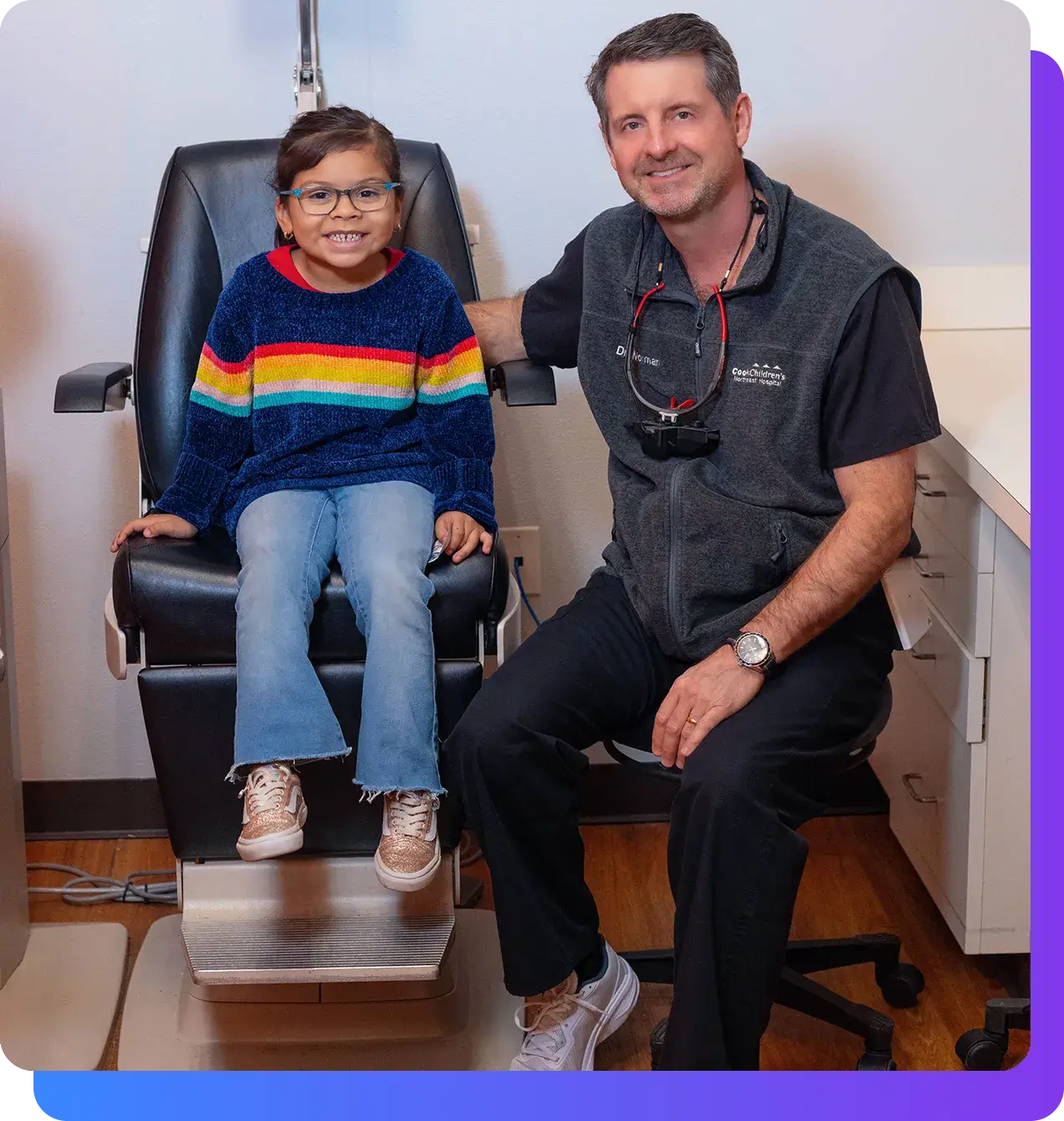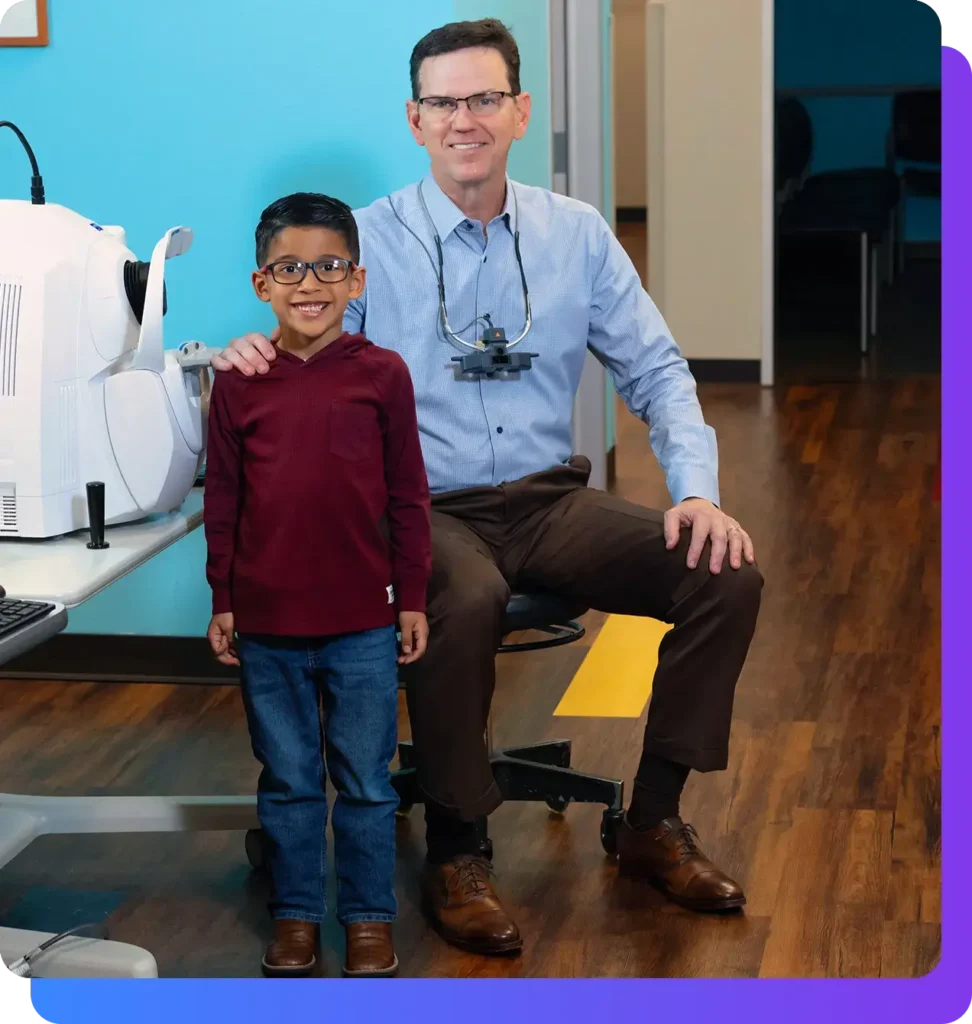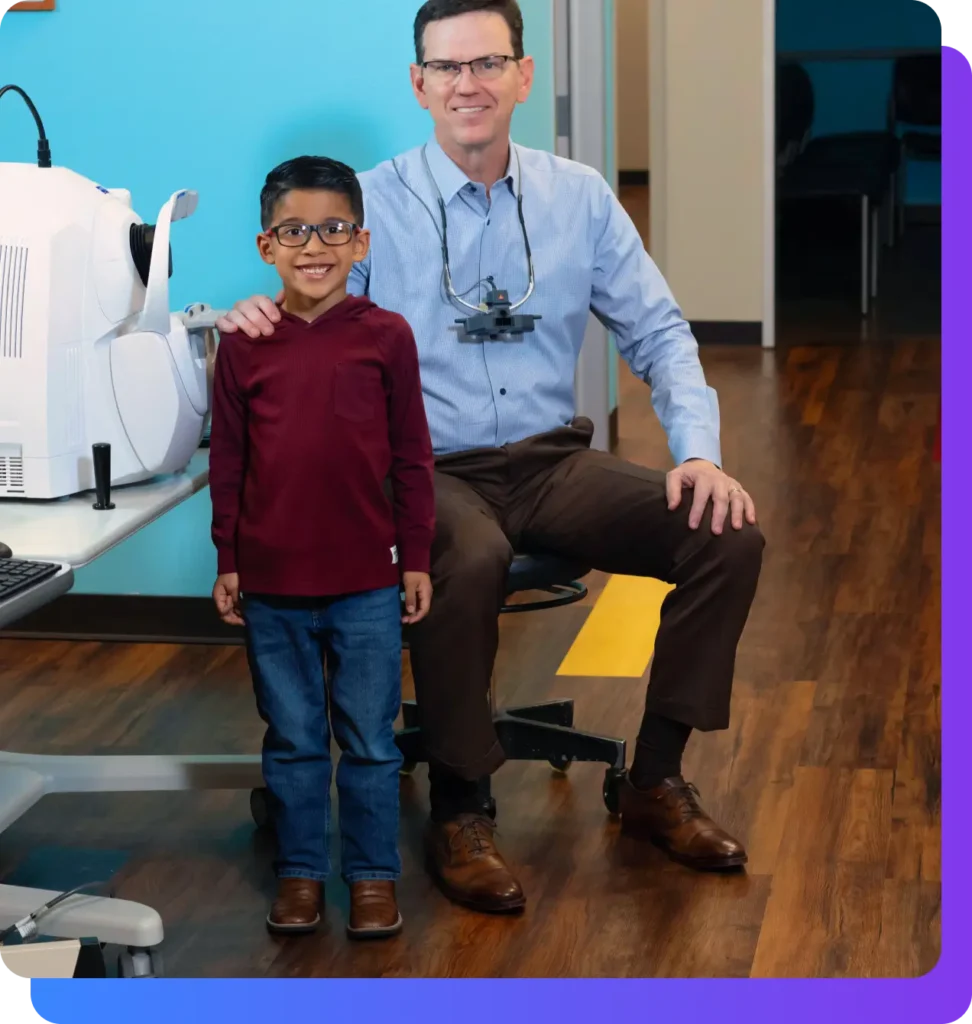Pediatric Exotropia (Outwardly Turned Eyes)
Specialists in North Texas
Discovering that your child may have pediatric exotropia, a condition where one or both eyes turn outward, can create worry and many questions, leading to great concern about your child’s ability to see the world clearly and interact with it confidently.
Expert Exotropia Treatment for North Texas
At Pediatric Eye Specialists, we meet your worry with understanding and your questions with clarity. We dedicate ourselves to not only addressing your child’s unique visual needs but also to providing a sanctuary of support for you and your family. We know that behind every child’s gaze is a world of potential, and our mission is to ensure that nothing, especially exotropia, obstructs your child’s bright and vibrant future. With a combination of state-of-the-art diagnostics, personalized treatment plans, and a nurturing approach to care, Pediatric Eye Specialists stands as a beacon of hope and a partner in the journey to correct your child’s vision. Our team, armed with extensive expertise in pediatric ophthalmology, is committed to guiding you through this process with compassion and working to ensure the best possible outcome for your child.

The Basics: What is Exotropia in Children?
Exotropia in children is an eye condition characterized by one or both eyes turning outward away from the nose, which can disrupt binocular vision and depth perception. This misalignment can be constant or intermittent, becoming more noticeable when the child is tired or focusing on distant objects. Often referred to as “wall-eyed,” exotropia can range from a slight outward deviation to a more pronounced turn that is readily apparent. The condition might be present at birth, known as congenital exotropia, or develop later in childhood. Early detection and treatment are key to preventing potential visual impairment, such as amblyopia (lazy eye), and to promote the development of proper binocular vision, ensuring children can engage fully with their environment. Pediatric Eye Specialists focuses on understanding the unique aspects of each case of exotropia, providing comprehensive care tailored to support the visual health and overall well-being of every child.
Why Choose Pediatric Eye Specialists for Pediatric Exotropia
The Most Experienced Team in North Texas
With over sixty-five years of collective pediatric ophthalmology expertise, we offer your child unparalleled collaborative care.
Five Convenient Locations
Easily accessible care with offices in Fort Worth, Denton, Southlake, Mansfield, and Prosper,
Unrushed, Clear Communication
We take the time to discuss your child's diagnosis and treatment, ensuring all your questions are answered to ease your concerns.
Affiliated with Cook Children’s Hospital
Our partnership with Cook Children’s Hospital means if your child needs surgery, imaging, or other specialists, they will be treated in one of the nation’s leading pediatric hospitals.
Specialized Expertise
Our expertise means that more optometrists, doctors, and specialists refer their pediatric eye patients to Pediatric Eye Specialists than any other pediatric eye practice in North Texas.
Child and Family Focused
Kids love us, and we love kids! We provide a caring environment for your child and your family.
Advanced Diagnostic Technology
We have the most comprehensive pediatric diagnostic suite in North Texas, allowing for precise diagnosis and highly personalized treatment plans.
Every Child Needs Access to Expert Eye Care
Championing the right to sight, we help navigate insurance, cash pay, and Medicaid options to make superior eye care feasible for all children regardless of their socioeconomic status.

The Benefits of Early Treatment of Exotropia
Early treatment of pediatric exotropia offers numerous benefits that can significantly enhance a child’s visual development and overall quality of life.
Success You Can Expect for Your Child
Improves Vision and Depth perception
Correcting exotropia can bring the eyes back into alignment and allow binocular vision to develop, improving visual accuracy and depth perception.
Reduces Risk of Amblyopia
Left untreated, exotropia can cause the eyes to lose coordination, increasing the chances of amblyopia (lazy eye). Early treatment lowers this risk.
Relieves Eye Fatigue and Strain
Misaligned eyes require increased effort to focus, which often causes headaches, squinting, and discomfort. Treatment allows the eyes to work in sync.
Boosts Self-ConfidenceBoosts Self-Confidence
After treatment, straightened eyes may allow your child to feel less self-conscious about their appearance and making eye contact.
Expands Academic and Sports Opportunities
Proper alignment and coordination of the eyes maximizes your child’s potential to learn, read effectively, and even pursue sports requiring visual tracking and judgment.
Prepares for a Lifetime of Healthy Vision
Treating exotropia early leads to the best possible visual outcomes for your child over a lifetime.
Real Stories,
Real Smiles.
“They were very good with my nonverbal toddler. It was the best doctor visit experience we have had yet. They were awesome, caring, and quick!.”

Amy Glover
Parent of Patient
“Today, Dr. Packwood saved my youngest from a life of blindness and worked a miracle for my family. I cannot express enough gratitude and thanks for their skillful surgery and expertise. 10 of 10 highly recommend.”

Atticus Lee
Parent of Patient
“The staff here is so amazing with my son. We had such a wonderful experience both at the office and for his surgery! I highly recommend Pediatric Eye Specialists!!!!“

Gianna Stutzman
Parent of Patient
“We are so grateful for the genuine care that Dr. Duff provided for our son Lorenzo, which prevented him from going blind! She is truly a gift to the community.“

JS Cocjin
Parent of Patient
“Professional, compassionate, kind and friendly. They took great care of my preemie baby from Day 1 of ROP. Very happy with how my daughter is progressing and has healthy eyes now.”

Suresh K.C.
Parent of Patient
“We’ve seen Dr. Hunt for the past 6 years since my daughter was 9 days old. We have multiple appointments each year and even eye surgery when she was 1. Our experience here has been fantastic every time and we highly recommend this group!.”

Mandy Edmondson
Parent of Patient
“Dr. Norman has always been very attentive and thorough with my daughter, who has Type 1 Diabetes. The staff are warm and always do their best to be accommodating. I highly recommend Dr. Norman.”

Tricia Moon
Parent of Patient
“Absolutely recommend! All around great experience! They made my son feel comfortable during the visit. Treatment was explained, and I walked out with no questions. I loved it. “

Cynthia Valero
Parent of Patient
“Great staff, great doctors; they know how to help ease kids’ fears and provide excellent service. Had to get my little one in same day for an eye injury, and they found a way to make it happen. Would 100% recommend.“

Kris K
Parent of Patient
Start your child’s journey to better vision today.
Embrace a future of clearer vision and confidence for your child. Contact us now to book your consultation at any of our convenient locations across the Metroplex.
Click to Explore Pediatric Exotropia
Causes of Pediatric Exotropia
A deep understanding of the underlying causes of pediatric exotropia is crucial for devising targeted treatment plans. Exotropia, which is characterized by an outward turning of one or both eyes, can result from a variety of factors:
Genetic Factors
Similar to esotropia, exotropia can sometimes be linked to genetics, suggesting that children with a family history of strabismus have an increased likelihood of developing the condition.
Refractive Errors
While hyperopia (farsightedness) is commonly associated with esotropia, myopia (nearsightedness) or astigmatism can sometimes lead to exotropia as the eyes struggle to align properly.
Muscular Imbalance
An imbalance in the external eye muscles can cause the eyes to drift outward, especially if the muscles are not working synchronously due to control issues in the brain’s ocular centers.
Congenital Factors
Exotropia that is present at or soon after birth is known as congenital or infantile exotropia, indicating that it can be a developmental issue noticed early in life.
Neurological Disorders
Certain conditions affecting brain function, such as cranial nerve palsies or broader neurological disorders, can manifest as exotropia.
Premature Birth
Like esotropia, exotropia is also more prevalent in children born prematurely, potentially due to the visual system’s incomplete development at the time of birth.
Associated Conditions
Sometimes, exotropia is part of wider syndromic presentations, which could include systemic or neurological conditions, making it important to evaluate the child holistically.
Pediatric Eye Specialists aims to identify the specific causes behind each case of exotropia to tailor the most effective treatment strategies. Early recognition and management are vital to improving visual function and preventing the long-term effects of untreated exotropia.
Understanding these causes is vital for Pediatric Eye Specialists in diagnosing and formulating an effective treatment plan for exotropia.
Signs and Symptoms of Exotropia: Identifying Early Indicators for Prompt Intervention
Detecting the signs and symptoms of pediatric exotropia early on is key to ensuring timely and effective treatment. Parents and caregivers should watch for the following signs that could indicate exotropia in their child:
Outward Drifting of Eyes
The primary sign of exotropia is the noticeable outward deviation of one or both eyes, which might become more apparent when the child is looking into the distance or is fatigued.
Squinting or Eye Closing
Children may squint or close one eye, especially in bright light or while focusing on distant objects, in an attempt to see more clearly and to reduce double vision (diplopia).
Head Tilting or Turning
To compensate for misaligned vision, a child with exotropia might turn or tilt their head to align their eyes better when focusing on an object.
Difficulty with Depth Perception
Without proper binocular vision, children with exotropia can struggle with tasks that require depth perception, such as catching a ball or navigating stairs.
Eye Strain and Headaches
The extra effort needed for a child with exotropia to focus and align their eyes can lead to symptoms of eye strain (burning, watery eyes, difficulty focusing) and associated headaches.
Amblyopia Risk
Exotropia can cause a child to consistently favor one eye over the other, which increases the risk of developing amblyopia, where the lesser-used eye becomes “lazy” and vision can deteriorate.
Frequent Blinking or Rubbing Eyes
A child with exotropia may frequently blink or rub their eyes to clear blurred vision or alleviate discomfort.
Photophobia
Children might demonstrate light sensitivity or photophobia due to the challenges of controlling eye alignment in bright conditions.
Have Concerns?
Prompt recognition and intervention are essential for managing exotropia effectively. Pediatric Eye Specialists provides comprehensive assessments and tailored treatment approaches to address the unique needs of each child with exotropia, promoting optimal visual development and health.
Diagnosing Pediatric Exotropia: Comprehensive Diagnostic Approach
Diagnosing pediatric exotropia is a multifaceted process involving a series of clinical evaluations and, when necessary, specialized imaging to ascertain the extent and nature of the condition:
Initial Clinical Assessment
A thorough examination begins with a detailed medical history and observation of the child’s eye alignment and behavior. Pediatric Eye Specialists is adept at engaging children to ensure accurate assessment even in young or nonverbal patients.
Visual Acuity Testing
To determine the impact of exotropia on vision, specialists conduct visual acuity tests. This may involve child-friendly charts or images to evaluate how well the child sees at various distances.
Refraction Assessment
Refractive errors can contribute to or exacerbate exotropia, so cycloplegic refraction (using eye drops to temporarily suspend the eye’s accommodation ability) is performed to precisely measure and evaluate the eye’s focusing power.
Ocular Motility Examination
To assess the function of the extraocular muscles responsible for eye movement, doctors observe the eyes’ movements in all directions. This test can help identify any underlying muscle weakness or restriction.
Binocular Function Tests
Since exotropia affects binocular vision, tests such as the cover-uncover test and prism cover test are used to evaluate how the eyes work together and to measure the angle of deviation.
Stereopsis Measurement
Stereopsis, or depth perception, can be impaired in children with exotropia. Tests with special patterns or 3D glasses help assess the child’s ability to correctly perceive depth.
Imaging Studies
In some cases, imaging studies like MRI or CT scans may be recommended if a neurological cause is suspected or to rule out other abnormalities that might affect eye alignment.
Sensory Testing
For children with suspected amblyopia, sensory tests can determine if there is reduced vision in one eye, which is crucial for planning effective treatment.
Prism Adaptation Test
Specialists use prisms of varying strengths to determine the degree of exotropia and how well the eyes can adapt to alignment correction, providing valuable data for planning potential surgical interventions.
By using a comprehensive diagnostic approach, Pediatric Eye Specialists can accurately diagnose pediatric exotropia and create a personalized treatment plan that addresses all aspects of the child’s vision needs.
Treatments for Pediatric Exotropia: A Spectrum of Options
Pediatric exotropia, characterized by an outward deviation of one or both eyes, requires a tailored treatment plan that may include nonsurgical and surgical options. At Pediatric Eye Specialists, we explore the full spectrum of treatments to correct exotropia and improve binocular function.
Nonsurgical Treatments:
Glasses with or without Prism Correction: For children with refractive errors such as nearsightedness or farsightedness, corrective lenses can sometimes reduce the exotropic deviation. Prisms may be added to glasses to help align the eyes for those with significant deviation.
Patching Therapy: In cases where exotropia has led to amblyopia, patching the stronger eye can encourage the use of the weaker eye, potentially improving alignment and vision.
Medications: In specific instances, medications such as botulinum toxin (Botox) injections can be used to temporarily alter muscle dynamics, offering a less invasive option compared to surgery.
Surgical Treatments:
Strabismus Surgery: When nonsurgical methods are insufficient, strabismus surgery on the muscles that control eye movement may be necessary. Procedures may involve tightening or loosening muscles to change the eye’s position and improve alignment.
Muscle Recession or Resection: Depending on whether the muscles need to be weakened or strengthened, either a recession (moving the muscle attachment back) or resection (removing a segment of the muscle) will be performed.
Adjustable Sutures: For greater precision and customization, adjustable sutures allow for fine-tuning of eye alignment postoperatively, once the patient is fully awake.
Each child’s case of exotropia is unique, and our team at Pediatric Eye Specialists is committed to providing a comprehensive evaluation to determine the most effective treatment plan. Our goal is to not only straighten the eyes but also to address the underlying visual dysfunction, ensuring the best possible outcome for each child’s vision and quality of life.
Our commitment at Pediatric Eye Specialists is to provide your child with the highest standard of care, combining medical expertise with compassion and understanding.
Typical Expected Outcomes for Pediatric Exotropia Treatments
When addressing pediatric exotropia, Pediatric Eye Specialists aims for outcomes that significantly improve a child’s quality of life and visual capabilities. The typical expected outcomes can vary depending on the individual case, but the goals of treatment are consistent: alignment improvement, enhanced binocular vision, and prevention of amblyopia.
Alignment Correction
The primary goal is to achieve proper eye alignment, which is often attainable through a combination of treatments. Following treatment, most children experience a marked reduction in the outward turning of the eye.
Improved Binocular Vision
Treatments aim to enhance the brain’s ability to use both eyes together, improving depth perception and stereopsis. This leads to better coordination and visual understanding of the environment.
Prevention or Reversal of Amblyopia
Early intervention is crucial for preventing the development of “lazy eye,” or amblyopia. In cases where amblyopia has begun to set in, treatment can often reverse its effects, improving vision in the weaker eye.
Reduction of Associated Symptoms
Symptoms such as eye strain, headaches, and difficulties with judging distance should diminish after successful treatment. This can lead to improved comfort and concentration in daily activities.
Social and Emotional Benefits
Correcting exotropia can lead to enhanced self-esteem and social interactions for children who may have been self-conscious about their appearance or had difficulty engaging with peers due to their condition.
Long-term Stability
While some children may require additional treatments as they grow, many enjoy long-term stability of their eye alignment after treatment, especially when interventions occur early in life.
It’s important to note that while the goal is always to improve vision and alignment to the greatest extent possible, the degree of success can be influenced by factors such as the age at treatment onset, the severity of the exotropia, and the presence of other health conditions. Regular follow-up care is essential to monitor progress and make any necessary adjustments to the treatment plan.
Secure A Brighter Future: Schedule Your Child's Exotropia Consultation Today
Addressing pediatric exotropia early is crucial for effective treatment and a positive outcome. At Pediatric Eye Specialists, we are dedicated to providing your child with the highest quality of care. Don’t wait to take action. Schedule a consultation with our experts today and take the first step towards a brighter, clearer future for your child. Let us help enhance your child’s vision and confidence with our comprehensive and compassionate approach.

Start your child’s journey to better vision today.
Embrace a future of clearer vision and confidence for your child. Contact us now to book your consultation at any of our convenient locations across the Metroplex.
What is the difference between exotropia and strabismus?
Exotropia is a type of strabismus, which is the general term for any misalignment of the eyes. Specifically, exotropia refers to the outward turning of one or both eyes, whereas strabismus can include any direction of misalignment.
At what age can exotropia be treated in children?
Treatment for exotropia can begin as soon as a diagnosis is made, which can be in infancy or early childhood. Early intervention can lead to better treatment outcomes and prevent long-term vision problems.
Can exercises help correct my child’s exotropia?
Convergence insufficiency, a specific type of exotropia in which the drifting out of the eyes occurs mainly or only when the child is focusing at near, can sometimes improve with eye exercises. Most other forms of exotropia do no respond to eye exercises.
Will wearing glasses fix my child’s exotropia?
Glasses, especially with prism correction, can be used to treat exotropia, particularly if the condition is associated with a refractive error. However, not all cases can be managed with glasses alone, and some may require surgical intervention.
How often will my child need to be seen by their ophthalmologist after exotropia treatment?
The frequency of follow-up visits after exotropia treatment can vary. Initially, your child may need to be seen more frequently to monitor their progress. Once their condition stabilizes, the intervals between visits may be extended.
Can exotropia come back after it has been treated?
There is a possibility of recurrence, which is why regular follow-up care is important. Recurrence can be managed with additional treatments, which may include further vision therapy, prism glasses, or additional surgery, depending on the individual case.
What should I expect during an eye examination for my child with suspected exotropia?
During an eye examination for exotropia, the ophthalmologist will assess your child’s eye alignment, muscle function, and how well the eyes work together (vergence). The exam may include tests for visual acuity, monocular and binocular functions, and may involve cycloplegia (eye drops) to relax the eye muscles for accurate measurement of refractive error.
Is exotropia a birth defect or can it develop later in life?
Exotropia can be a congenital condition, meaning it is present at birth, or it can develop later in childhood or adulthood. Factors like genetics, muscle control, and even some birth defects can contribute to its development.
How does convergence insufficiency lead to exotropia?
Convergence insufficiency is a condition where the eyes do not work together properly while trying to focus on close objects and is subset of exotropia. The lack of normal convergence causes one eye to drift outward when focusing on near tasks.
What role does the human eye structure play in the development of exotropia?
The structure and function of the human eye are crucial in maintaining proper eye alignment. Any abnormalities in the eye muscles, nerves, or other structures may lead to exotropia by preventing the eyes from aligning and focusing correctly.
What does it mean if my child has exophoria along with exotropia?
Exophoria is a latent form of exotropia where the outward deviation of the eyes is only noticeable when the binocular vision is disrupted, such as when one eye is covered. If your child has both conditions, it means the tendency for the eye to turn outward is present even when both eyes are open and attempting to focus together.
Can cycloplegia help in diagnosing exotropia?
Yes, cycloplegia, which is the use of eye drops to paralyze the ciliary muscle of the eye and check for nearsightedness or farsightedness, is used during eye examinations to temporarily suspend the eye’s ability to accommodate or focus. This helps in accurately determining the full refractive error and can be essential in diagnosing and planning treatment for exotropia.
How does exotropia affect everyday life for infants compared to adults?
For infants, exotropia can significantly impact the development of binocular vision, which can affect depth perception and motor skills. In adults, it can cause double vision and impair the ability to perform tasks that require precise visual alignment. In both cases, treatment can help improve vision and quality of life.